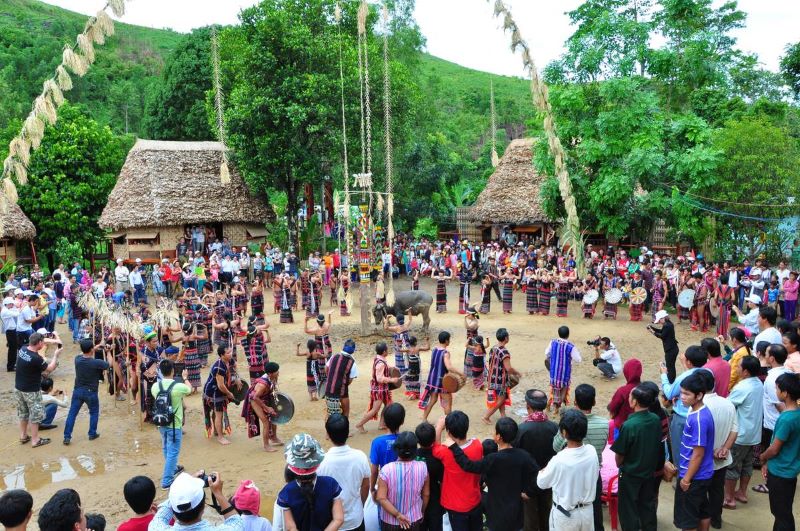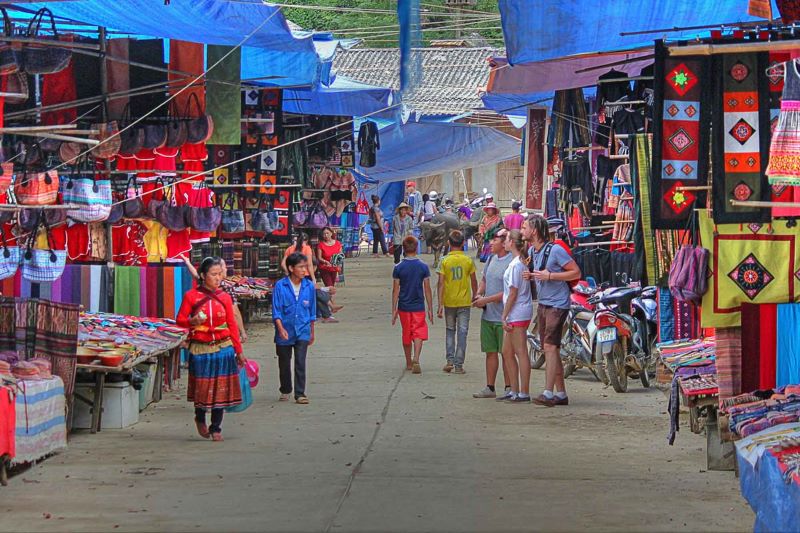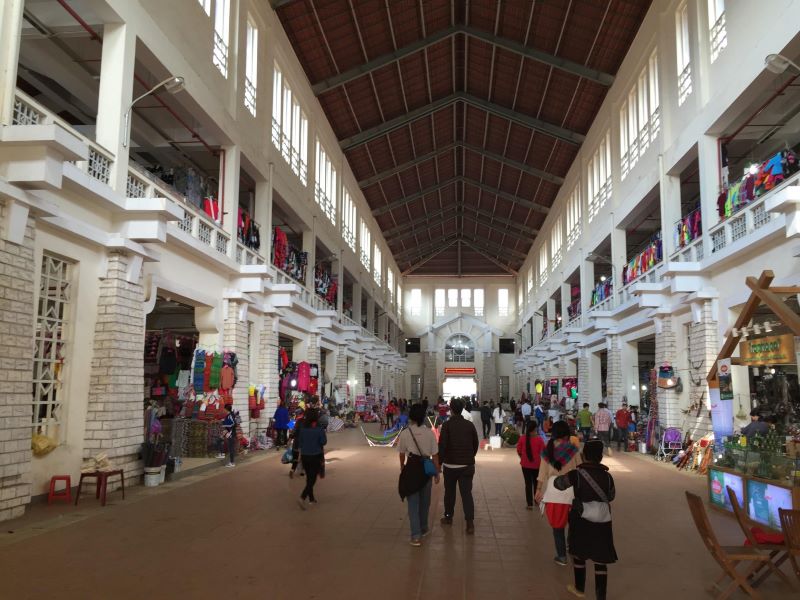In February, Sapa dons a new coat, as beautiful as a painting, with the perfect combination of misty mountain ranges and a rich, vibrant culture. Located in the northwest of Vietnam, the weather in Sapa in February brings many surprises, making each street feel fresh and new. Let’s explore the hidden beauty of Sapa in February, from choosing the right clothing for the cold to the must-try experiences while admiring the stunning landscapes of this enchanting land.
What is the weather like in Sapa in February?
Sapa in February is one of the best times to explore the beauty of this region, thanks to its distinct weather and cool climate. Located at an altitude of 1,650 meters above sea level, surrounded by dense forests and mountains, Sapa in February often experiences thick fog, giving the town a mysterious and enchanting appearance. With temperatures ranging from 8 to 14°C, a day in Sapa in February typically has about four hours of sunshine.

What’s fascinating about the weather in Sapa in February is its unpredictability; you might experience various weather conditions within a single day—starting with thick fog in the morning. Then giving way to more sunshine in the afternoon and possibly returning to fog in the evening. The humidity can reach up to 82%, but thanks to the cool mountain air, you won’t feel uncomfortable. For those who love adventure, February in Sapa is an ideal time to engage in outdoor activities.
Reasons to visit Sapa in February
February marks the beginning of spring in Vietnam when nature awakens after the cold winter. In Sapa, you will be able to witness the stunning beauty of peach and plum blossoms covering the high mountains. The light rains and misty fog add to the magical and romantic atmosphere of the place in the early days of spring.

As February is a transition period between winter and spring, snow can fall in lower-temperature areas like Fansipan Peak. This is a perfect opportunity to witness the beautiful snowfall, a breathtaking sight that is considered one of the most magical landscapes in Asia. If you enjoy tranquility and don’t mind the cold weather, Sapa in February will offer you incredibly fascinating experiences. Additionally, February is the off-peak tourist season, so Sapa won’t be overcrowded, allowing you to enjoy a peaceful and relaxing atmosphere.

Sapa in February offers several activities you should not miss
When visiting Sapa in February, you may wonder what to do to fully enjoy your trip. Don’t worry; we’ve compiled a list of exciting activities that you can’t miss. Although the weather in Sapa in February can sometimes be harsh, it also creates a mysterious and unique atmosphere for your adventure. Let’s explore the fascinating activities that will allow you to experience the cultural and natural beauty of Sapa in February:
Festival Atmosphere in Sapa in February
February often coincides with the Lunar New Year, making it the perfect time to experience the festive atmosphere of spring in Sapa. The Lunar New Year is not only an important holiday but also an opportunity to immerse yourself in the rich cultural traditions, where both locals and tourists come together to celebrate the new year. This is the ideal time to witness the blend of ancient customs and modern festivities, offering an unforgettable experience. Some notable festivals you shouldn’t miss when visiting Sapa in February include:
Tet Nhay Festival: Every year, the Red Dao people in Sapa organize a unique Tết festival called the “Tết Nhảy” or the dancing festival. This festival typically takes place on the first or second day of the Lunar New Year, sometimes extending to the third day. The primary purpose of this festival is to honor and seek blessings from ancestors for the prosperity and happiness of the family and community.

Roóng Poọc Festival: The Roóng Poọc Festival of the Giay people is a celebration to wish for bountiful harvests, healthy livestock, and peaceful villages. The festival includes many rituals, such as erecting a totem pole, and traditional games like ball throwing and plowing competitions. Each activity in the festival symbolizes the harmony of opposing forces and the prosperity of life.

Gau Tao Festival: The Gau Tao Festival is an important festival for the H’mong people in Lao Cai. This festival aims to seek blessings or change one’s fate. People who face difficulties, lack children, or are going through challenging circumstances invite a shaman to organize the Gau Tao ceremony in hopes of improving their lives, whether it be through fertility, prosperity, or happiness.

Visit the Local Markets and Experience the Vibrant Culture
If you enjoy immersing yourself in local culture and discovering unique destinations, wandering through the vibrant local markets is definitely an experience you shouldn’t miss:
Bac Ha Market: One of the must-visit markets when you are in Sapa is the Bac Ha Market, located in the northern part of Vietnam. This vibrant market offers a variety of handcrafted goods, traditional textiles, and fresh, colorful produce. During sapa in February, you’ll have the chance to explore not only the unique products but also experience the warmth and friendliness of the sellers. They are eager to share stories about their products, giving you a deeper understanding of the culture and history of the area.

Phong Hai Market: Not far from Bac Ha, you’ll find the Phong Hai Market, known for its traditional dishes and street snacks that are a true reflection of Vietnamese cuisine. The air here is filled with the tempting aromas of freshly cooked street food, as both locals and tourists gather to enjoy these delicious treats. Phong Hai Market isn’t just a place for trading; it’s also a fantastic spot to indulge in the local food and immerse yourself in the lively atmosphere of the Northwestern region.

Sapa Market: This market is one of the most famous spots in Sapa, where you can find unique souvenirs that reflect the local culture. Sapa Market is filled with handcrafted jewelry, intricate woven fabrics, and other regional specialties, perfect for taking home as gifts for friends and family. The market is not only a shopping destination but also a place where you can experience the blend of different cultures, with the presence of various ethnic minorities and their unique way of life.

Taste the Unique Cuisine and Local Flavors
Sapa is not only famous for its stunning natural landscapes but also for its diverse and unique culinary offerings. Here are some must-try dishes when visiting Sapa:
Lon Cap Nach: One of the most iconic dishes you must try in Sapa is Lon Cap Nach, or “piglet carried on the back”. This dish features tender pork that is cooked with local herbs and spices, creating a flavorful and rich taste. It’s not only delicious but also reflects the culinary skills of the local people.

Thang Co: Another signature dish of the H’mong people is Thắng Cố, a hearty and flavorful soup made with beef, bones, and traditional spices. This warming dish is perfect for chilly days in Sapa and is not only nourishing but also easy to enjoy. It’s a dish you’ll definitely want to savor during your visit.
Com Lam: A traditional dish of the mountain people, Cơm Lam is rice cooked in bamboo tubes, which infuses the rice with the natural aroma of bamboo and earth. The rice is soft, fragrant, and has a unique flavor that comes from the bamboo, offering a comforting and authentic taste of the region. Simple yet delicious, it’s a dish that captures the essence of Sapa’s mountain cuisine.

Xoi Bay Mau: A vibrant and delightful dish that you can’t miss in Sapa is Xôi Bảy Màu (Seven-Colored Sticky Rice). This dish is made with sticky rice dyed with natural plant extracts, creating a colorful and eye-catching appearance. Each bite is a combination of rich flavors and textures, often topped with sweet ingredients like coconut and beans. It’s not only visually appealing but also a delicious treat.

Ca Hoi Thac Bac: If you’re a fan of fish, the fresh salmon from the Thác Bạc streams is a must-try. Known for its tender, rich, and fatty texture, the salmon is often served grilled, steamed, or fried, offering a fresh and nutritious experience. This dish is a true reflection of the diversity and abundance of Sapa’s cuisine and culture.
When you visit Sapa, make sure to indulge in these delicious local dishes to not only enjoy the breathtaking landscapes but also experience the rich flavors and culinary traditions that the region has to offer.
Essential Tips for Your Visit to Sapa in February
If you’re planning to visit Sapa in February, here are some helpful tips to make the most of your trip:
Shopping on the go: If you happen to forget some items, don’t worry too much as you can easily find stores in the center of Sapa town that sell a variety of goods. However, remember to bargain to get a good price.

Hire a local guide: If you’re planning to go on a trekking trip, especially in February when the weather can change unexpectedly, it’s a good idea to hire a local guide. Although Sapa is generally safe and easy to walk around, having someone who knows the area well will help you explore the best spots and make your trip safer.
Rent a motorbike for easy travel: If you want to explore Sapa freely, renting a motorbike is a great choice. With a motorbike, you can easily navigate through villages and enjoy the breathtaking views of the hills.

Meet the locals: While strolling around Sapa, you may encounter local women from ethnic groups selling souvenirs like bracelets and scarves. They might even follow you for a while, but don’t worry, they mean no harm. If you’re not interested in buying anything, simply decline politely and continue on your way.
Be cautious when buying items from the H’Mong people: If you decide to purchase textile products such as scarves or decorative rugs, be careful not to let them come into contact with your clothes. The natural dyes used to color the fabric may stain and only fade after a few washes.
Prepare suitable clothing: Since Sapa in February is quite cold and may experience drizzly weather, make sure to bring warm clothes, a waterproof jacket, and a light coat. Don’t forget to pack a raincoat or umbrella to protect yourself from unexpected showers. Additionally, bring extra socks, underwear, and comfortable shoes to ensure you can move around quickly.
If you’re looking to explore the true beauty and culture of Vietnam, the charming town of Sapa is definitely a must-visit destination. If you are considering a trip to Sapa in February, I hope the suggestions in this article help you plan the perfect itinerary. With its breathtaking scenery and unique weather in February, Sapa offers a mysterious and enchanting atmosphere that will elevate your travel experience.



